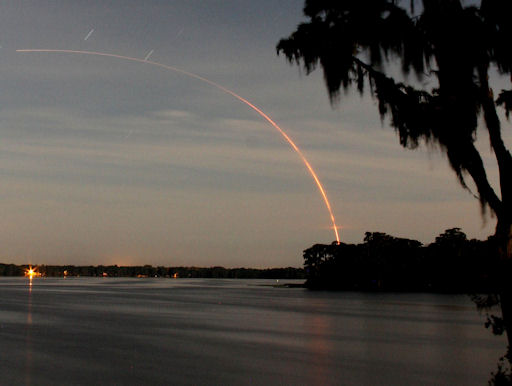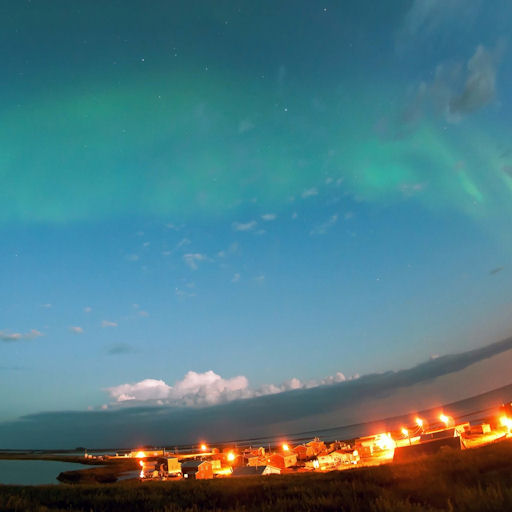BLUE MOON: The full Moon of August 31st is a "Blue Moon," the second full moon in a calendar month. But could the Moon actually turn blue? Today's story from Science@NASA discusses the possibilities. [video]
RADIATION BELT STORM PROBES: Most spacecraft try to avoid the Van Allen Belts, two doughnut-shaped regions around Earth filled with "killer electrons." This morning, NASA launched two heavily-shielded spacecraft directly into the belts. Mark Staples of Little Lake Santa Fe, Florida, photographed the Radiation Belt Storm Probes (RBSP) lifting off just after 4:05 am EDT:
"I am about 150 miles NW of the launch pad, but I could easily see the bright flame as the Atlas V cleared the trees and clouds," says Staples.
Shortly after launch, the twin probes were successfully released from the rocket's Centaur upper stage, kicking off a two-year mission to study the mysteries of the Van Allen Belts. "I'm very happy to report that we have two happy spacecraft on orbit," says Rick Fitzgerald, RBSP project manager from the John Hopkins University Applied Physics Laboratory, which is managing the mission for NASA.
The two probes now begin a 60-day commissioning period. During the next two months, operators will power up all flight systems and science instruments and deploy long antenna booms, two of which are more than 54 yards long. The Storm Probes are equipped with radio beacons that will rapidly transmit data back to Earth so members of the public can get a nearly-realtime look at conditions inside the belts. Stay tuned.
Realtime Space Weather Photo Gallery
SUMMER AURORAS: "Aurora season is back here in the Northwest Territories of Canada," reports Francis Anderson of Tuktoyaktuk NWT. "Although it does not get completely dark yet, the northern lights are once again visible. This first photo of the aurora was taken on August 25th from atop a pingo with a fairly large cumulonimbus cloud towards the southern horizon, which was flashing lightning every five or so minutes." (continued below)
"One of the warmest days I have ever shot the aurora, it was +16C at the time and +23C earlier that day," continues Anderson. "I'm looking forward to clear skies in the months ahead for an even better view of the Northern Lights."
He might not have to wait months. A medium-speed solar wind stream is buffeting Earth's magnetic field now, and this could stir up more Arctic lights tonight. NOAA forecasters estimate a 15% chance of geomagnetic activity. Aurora alerts: text, phone.

![]()
Solar wind
speed: 396.2 km/sec
density: 0.4 protons/cm3
explanation | more data
Updated: Today at 1454 UT
![]()
X-ray Solar Flares
6-hr max: M1 1211 UT Aug30
24-hr: M1 1211 UT Aug30
explanation | more data
Updated: Today at: 1500 UT
![]()
![]()
![]()
Daily Sun: 30 Aug 12
![]()
![]()
None of these sunspots poses a significant threat for strong flares. Credit: SDO/HMI
![]()
![]()
![]()
Sunspot number: 95
What is the sunspot number?
Updated 30 Aug 2012
Spotless Days
Current Stretch: 0 days
2012 total: 0 days (0%)
2011 total: 2 days (<1%)
2010 total: 51 days (14%)
2009 total: 260 days (71%)
Since 2004: 821 days
Typical Solar Min: 486 days
Update 30 Aug 2012
The Radio Sun
10.7 cm flux: 118 sfu
explanation | more data
Updated 30 Aug 2012
![]()
![]()
![]()
Current Auroral Oval:
![]()
Switch to: Europe, USA, New Zealand, Antarctica
Credit: NOAA/POES
![]()
![]()
![]()
Planetary K-index
Now: Kp= 1 quiet
24-hr max: Kp= 1 quiet
explanation | more data
![]()
Interplanetary Mag. Field
Btotal: 3.0 nT
Bz: 1.0 nT north
explanation | more data
Updated: Today at 1457 UT
![]()
![]()
![]()
Coronal Holes: 30 Aug 12
![]()
![]()
There are no large coronal holes on the Earthside of the sun. Credit: SDO/AIA.






